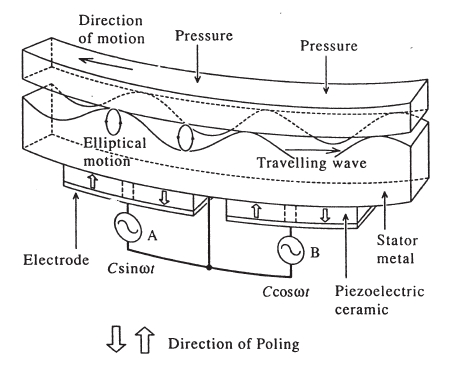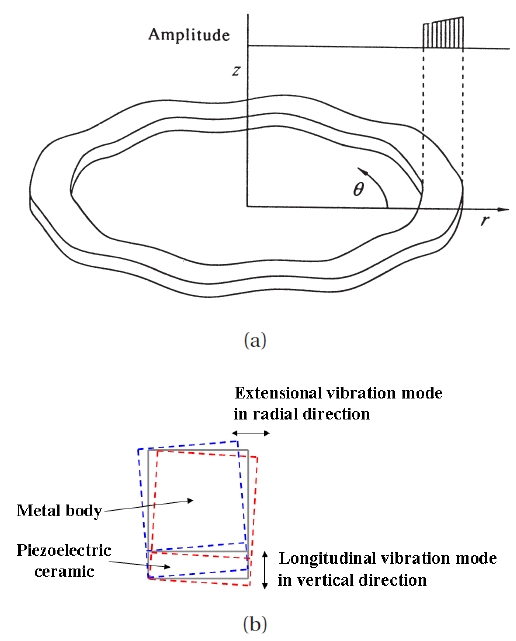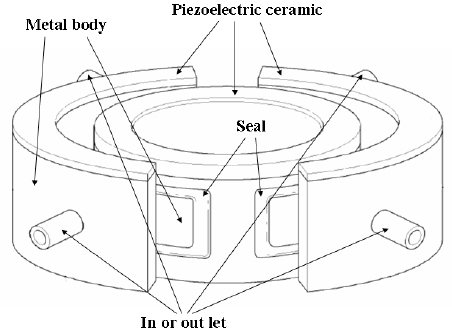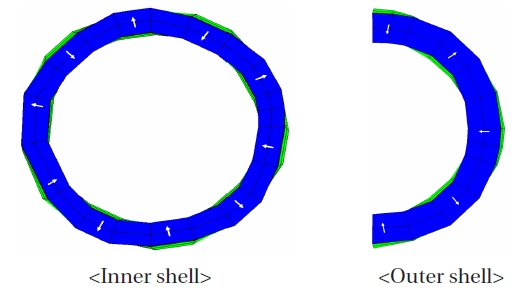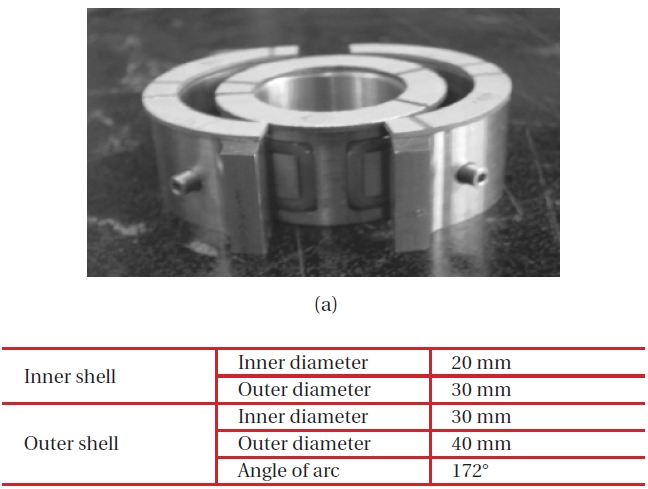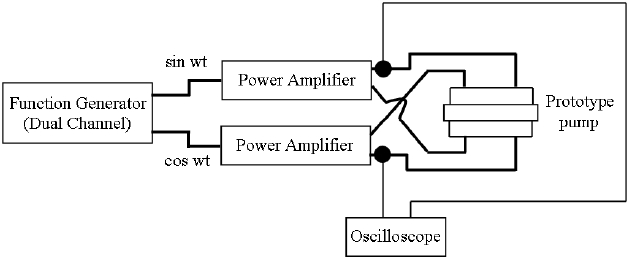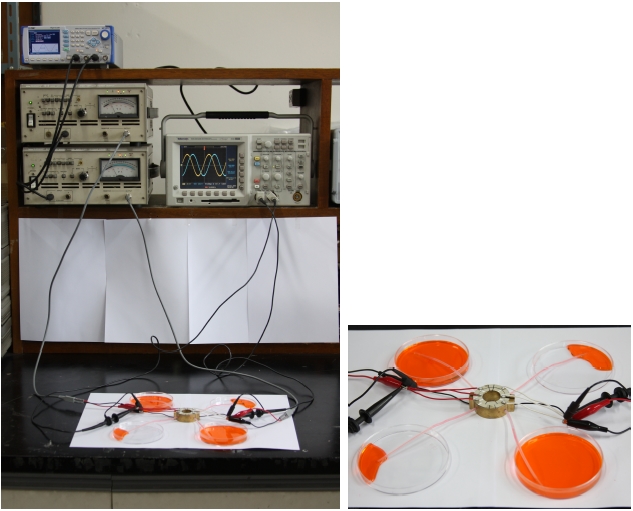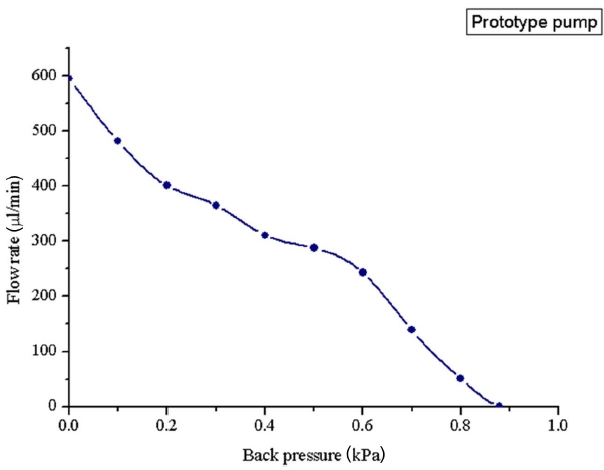



Micro-pumps have unique characteristics that are able to transport minute, as well as accurate, amounts of liquid or gas. Hence, micro-pumps are appropriate in dealing with chemical and biological substances by analyzing the system as a microfluid flow control appliance [1]. These devices generally consist of one or more chambers created by the deformation of the actuator and check valves in order to manage the fluid flow. However, check valves installed within micro-pumps raise problems such as pumping performance degradation via abrasion, fatigue and valve blocking, etcetera [2,3]. In order to solve the critical problems, extensive research and development upon valveless type pumps have been conducted. A valveless micropump, first proposed by Stemme and Stemme, used a diffuse/ nozzle structure, which was a substitution for the ability of the check valves [4]. Also, Bar-Cohen and chang [5], introduced the peristaltic pump using a flexural vibration mode of a traveling wave. This paper proposes an innovative valveless micro-pump type that uses an extensional vibration mode of a traveling wave as a volume transporting means. The proposed pump consists of coaxial cylindrical shells that join the piezoelectric ceramic ring and metal body, respectively. The main feature of this pump does not require the valves because the peristaltic action produces a tightly closed space that may play an important role by causing a squeezing effect. Also, when the input power is turned off, the sliding interface, formed between the coaxial shells against each other, stops the flow of fluid. Therefore, a self-locking action is automatically produced like a closing operation of the conventional check valves. In order to verify the operation principle of the proposed pump model, a numerical simulation analysis was conducted. Modal and harmonic analysis was carried out during its design phase and, based on the simulation results, we made a prototype micro-pump and tested its performance.
The operation principle of a traveling wave rotary type ultrasonic motor can be successfully applied to the fluidic transfer mechanism of a micro-pump. Figure 1 illustrates the operation principle of the traveling wave rotary type ultrasonic motor. Piezoelectric ceramic elements are used as vibrators and positioned at appropriate distance from one another for traveling wave excitation. Points on the surface of the stator ring move within elliptical trajectories and bents propagate as it stands in accordance with the passage of time. The metal disk or ring, which is pressed on the stator, is rotated by the tangential force at the contact surface [6].
In a piezoelectric ring of the actual motor, the vibration amplitude of the traveling wave increases towards the outer perimeter, as shown in Fig. 2(a) [7]. Therefore, the side wall of the elastic metal body ring, installed on the piezoelectric ceramic plate, excites the extensional vibration mode in its radial direction along the propagation of the traveling wave, as shown in Fig. 2(b). The space formed by this motion is used as a platform for the transportation of fluids. The proposed pump consists of coaxial cylindrical metal shells bonded with annular type piezoelectric ceramic plates in order to make full use of the extensional vibration mode effect. The inner shell is a ring and the outer shells are two semi-circle type parts, as shown in Fig. 3. Because the proposed micro-pump uses coaxial cylindrical shells, the slide contact surface between the inner and outer shells is able to make chambers via the proper operation mode setting.
[Table 1.] Dielectric and piezoelectric properties of piezoelectric ceramic.

Dielectric and piezoelectric properties of piezoelectric ceramic.
A numerical simulation analysis for the proposed model was implemented in order to verify the pump operation mechanism. Finite element modeling software, ATILA, was used for this process. Modal and harmonic analysis were both carried out for the inner and outer shells of the pump, respectively. According to the wave mode and variation of the pump body shape, the distribution of both the vibration amplitude and operational frequency was changed. Figure 4 roughly illustrates the deformation of the inner and outer shells under the operation condition. When the traveling wave occurs, excitation of extensional vibration mode in radial direction is confirmed. (i.e. white arrows)
The variation of both the extensional vibration amplitude and resonance frequency due to the wave mode and elastic body length ratio is presented in Fig. 5, respectively. Body length ratio defines the proportion between the height and width for the elastic metal body. The widths of the inner and outer metal body were fixed to 5 mm and the height of it was modified. Analysis of the wave mode was executed under a 1-length ratio condition, and analysis on the length ratio was fulfilled under a 5-wave mode condition.
A prototype valveless micro-pump was fabricated in accordance with the simulation result. The 5-wave mode and 3-length ratio type model was selected due to the relatively high vibration amplitude and low operational frequency characteristics. Piezoelectric ceramic plates, manufactured via the conventional fabrication method, were bonded to the inner and outer metal shells, respectively.
The exact composition of piezoelectric ceramics was produced using 0.9Pb(Zr0.51Ti0.49)O3-0.1Pb(Mn1/3Nb1/3Sb1/3)O3 + 0.05Cr2O3. In order to remarkably increase the dielectric and piezoelectric properties, Leadoxide(PbO) - Zirconate(ZrO2) - Titanate(TiO2) and Manganate(MnO2) - Niobate(Nb2O5) - Antimonate(Sb2O3) were mixed [8]. Also, Cr2O3 was added to raise the value of the mechanical quality factor (Qm) and to drop the dielectric loss(tanδ ). The mixing ratio was determined by considering the morphotropic phase boundary (MPB) in order to maximize the piezoelectric characteristics. Its prominent properties are shown in Table 1. This piezoelectric ceramic material has a high electromechanical coupling factor (kp), a high mechanical quality factor and a low dielectric loss. Therefore, we are able to determine that it can also successfully be used in other piezoelectric devices. The components and dimensions of a prototype pump are presented in Fig. 6.
In order to operate the prototype pump, we constructed a driving system. This system is composed of two channel function generators producing two phase voltages having 90 degrees of phase difference for traveling wave excitation within the piezoelectric ceramic plates, the power amplifier for the voltage magnitude increase and the oscilloscope for the voltage input state check. Figure 7 shows a diagram of the operating system.
The performance of the proposed micro-pump was measured in terms of the pump limits for flow rate and back pressure. Figure 8 shows the experimental situation of the prototype pump performance test. For the case of the flow rate data acquisition, the measuring method used an accumulated amount of water by utilizing the pumping operation for a specified period of time. Also, the determination of pump back pressure was measured by the height of pumping water into the vertical tube. The maximum flow rate was 595 μL/min and the highest back pressure was 0.88 kPa at an input voltage of 130 Vrms. Additionally, we verified that the fluid flow direction was easily changed via the phase control between the two input voltage sources. The flow rate or the back pressure characteristic of a prototype micro-pump is shown in Fig. 9.
This paper proposes an innovative valveless piezoelectric micro- pump type that is able to transport fluid by an extensional vibration mode of a traveling wave. This pump has the body shape of a coaxial cylinder, and is able to form multiple chambers due to vibration. In accordance with the variations in the exciting wave mode and pump body dimension, we analyzed the vibration displacement characteristics of the proposed model, determined the optimal design condition, fabricated the prototype pump from the analysis results and evaluated its performance. The maximum flow rate was approximately 595 μL/min and the highest back pressure was 0.88 kPa at an input voltage of 130 Vrms. We were able to confirm via this research that the peristaltic motion of the piezoelectric actuator could be effectively applied to the fluid transfer mechanism for the valveless type micropump.
